Shorenstein Report: Election News Coverage Failed the Voters
|
|
 One of my favorite galleries is Lacoste, in Concord, MA–which features nationally and internationally known ceramicists–as well as emerging artists. Founded by Lucy Lacoste, a ceramicist herself, the gallery shown the work of 80 or more artists. Over the years, I’ve much admired Lacoste’s striking displays–which have provided insight and inspiration for my own writing and art.
One of my favorite galleries is Lacoste, in Concord, MA–which features nationally and internationally known ceramicists–as well as emerging artists. Founded by Lucy Lacoste, a ceramicist herself, the gallery shown the work of 80 or more artists. Over the years, I’ve much admired Lacoste’s striking displays–which have provided insight and inspiration for my own writing and art.
The current exhibit, which runs November 19-December 4, 2016, is NORDIC LIGHT, features the work of Anne Fløche and Hans Vangsø, partners in life who work independently interpreting contemporary ceramics in Aarhus, Denmark. As Lucy Lacoste explains:
Anne Fløche is a Danish clay sculptor experimenting with various forms and colors in clay by using utensils or implements to make markings on clay surfaces. The color principles of terra sigillata, a clay slip used like a glaze, informs her application of colors which are subtle yet rich in scale. For Anne, clay is a broad canvas whereas glazes, engobes and slips are paints for her artistic expressions. In this exhibition, she is inspired by architectures of different geographical locations. Her sculptures are composed to form landscapes or cityscapes of an imagined world.
Hans Vangsø is a Danish studio potter mentored by the great Gutte Eriksen, following the rich Scandinavian and Japanese ceramic traditions. His works are simple in form and line yet the surfaces are highly textured. Multiple firing processes and unconventional treatments of surfaces are his hallmark. Vessels are bisque fired then applied with thick glazes, wrapped in seaweed or metal then tightly bound in newspaper before firing to a high temperature. Bubbles and blisters on the vessel surfaces as a result of these processes are unique in each vessel. Colors are subtle but there are unmistakable markings that appear to have gone through some form of geological stress.
Lacoste Gallery was introduced to the work of Hans Vangsø and Anne Fløche by William Hull, the pre-eminent curator of Danish ceramics in the US. They are partners and share a home on the east coast of Jutland, Denmark.
“We have shown Hans Vangsø many times over the years; this is the first full show with him and his partner Anne Fløche. Both are rooted in Scandinavian traditions yet are applying exciting and new treatments to ceramic art. They have come to symbolize the new in Danish ceramics” Lacoste said.
The current show runs through December 4, 2016. Next up is “New Pots, Utility 2, featuring the work of Linda Christianon and Jan McKeachie Johnston, from December 10, 2016-January 7, 2017. An opening reception with Christiabso and Johnston will be held on Saturday, December 10, 2016, from 3-5 pm; the artists will speak on Sunday, December 11, at 2 pm.
–Anita M. Harris
Anita M. Harris is a writer, photographer and communications consultant base in Cambridge, MA.
New Cambridge Observer is a publication of the Harris Communications Group, an award-winning pr and digital marketing firm in Kendall Square, Cambridge.
With all of the sturm, drang, disruption and depression in Cambridge last week after Donald Trump was elected President, I thought I’d retreat to upstate New York to commune with nature and art.
The nature went well,  but as it turned out, there was a shooting, probably gang-related, at Crossgates Mall, not far from my family home. There was news of hate crimes in New York and elsewhere. And I arrived at the Tang Museum at Skidmore College a few minutes too late for a community discussion of the election and its aftermath.
but as it turned out, there was a shooting, probably gang-related, at Crossgates Mall, not far from my family home. There was news of hate crimes in New York and elsewhere. And I arrived at the Tang Museum at Skidmore College a few minutes too late for a community discussion of the election and its aftermath.
The discussion had been held beneath an installation called “Flag Exchange,” comprised mainly of torn American flags. The flags collected as part of a multi-year project in which artist Mel Ziegler traveled across the US— offering new replacement flags for tattered ones flying at homes, post offices, businesses, and other public locations.  The exhibit also included picnic tables painted red, white, and blue–all aimed at provocation and one would hope thoughtful dialogue on the current state of democracy.
The exhibit also included picnic tables painted red, white, and blue–all aimed at provocation and one would hope thoughtful dialogue on the current state of democracy.
After accepting the gift of a safety pin (the post-Trump election symbol of solidarity with those who have experienced racism, homophobia, xenophobia and such), I did manage to escape somewhat into art in a wonderfully expansive exhibit called “Six-fold Symmetry: Pattern in Art and Science,” curated by Skidmore faculty from a variety of disciplines.*
Among my favorite pieces were:
Drawing Memory, 2016, a wall-sized installation in which Nigerian artist Victor Ekpuk (b. 1964) uses white chalk on  black-painted background to evoke and build on his understanding of Nsibidi, an African art form used by the secret Ekpe, or (Leopard Society). Art history Professor Emeritus Lisa Aronson writes that while he remains an outsider to the society, Ekpuk’s work resembles the dense and crowded aesthetic of Nsibidi (which is often played out on cloth) giving his viewers a complex display of imagery to decode. Ekpuk’s wall drawings mirror Nsibidi’s impermanent and performative nature, both in his preferred use of an erasable chalk medium and his practice of removing the murals from the wall at the end of exhibition.
black-painted background to evoke and build on his understanding of Nsibidi, an African art form used by the secret Ekpe, or (Leopard Society). Art history Professor Emeritus Lisa Aronson writes that while he remains an outsider to the society, Ekpuk’s work resembles the dense and crowded aesthetic of Nsibidi (which is often played out on cloth) giving his viewers a complex display of imagery to decode. Ekpuk’s wall drawings mirror Nsibidi’s impermanent and performative nature, both in his preferred use of an erasable chalk medium and his practice of removing the murals from the wall at the end of exhibition.
First Family–Hexagon, 2010
Iranian born Monir Farmanfarmaian (b.1924) synthesizes Persian history and artistic traditions and western geometrical abstraction in her mirrored sculpture “Hexagon.” According to Computer Science Professor Michael Eckman, the calculation and geometry of 14th century mosaics are closely tied to Sufism, the mystical aspect of Islam, and its sacred numerology. As Farmanfarmaian explains, “The six sides of the hexagon are the directions, forward, backward, right, left, up, down. 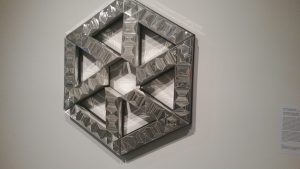 The hexagon also reflects the six virtues: generosity, self-discipline, patience, determination, insight and compassion. All the mosques in Iran, with all the flowers and the leaves and the curves and so on are based on hexagons. For me, everything connects with the hexagon.”
The hexagon also reflects the six virtues: generosity, self-discipline, patience, determination, insight and compassion. All the mosques in Iran, with all the flowers and the leaves and the curves and so on are based on hexagons. For me, everything connects with the hexagon.”
 Arachna’s Arcade, 2008, by Providence, RI, sculptor Dean Snyder (b. 1955) is a “drawing in space,” of a spider web. Its “silk” is composed of highly-polished steel–which makes the web appear almost photographic in that it transposes the outside garden into the Tang gallery, curator Rachel Seligman, associate professor of mathematics, points out.
Arachna’s Arcade, 2008, by Providence, RI, sculptor Dean Snyder (b. 1955) is a “drawing in space,” of a spider web. Its “silk” is composed of highly-polished steel–which makes the web appear almost photographic in that it transposes the outside garden into the Tang gallery, curator Rachel Seligman, associate professor of mathematics, points out.
Energy Scaffolds and Information Architecture (Return to Formlessness), 2015 With use of color pencil, graphite and architectural stencils on antique ledger book pages, the intricate drawings of American artist Louise Despond (b. 1983) emerge “organically”, beginning with a few marks on paper but with no formal plan. “Each drawing is a process of discovery, with a larger, universal force guiding the emerging patterns. This intuitive process generates imagery that is symmetrical, highly geometric and possessed of an expressive energy that she feels is connected both the spiritual realm and to nature,” Seligman writes.

Hours 1-8, 2016. In this series of oil paintings on linen, Grace DeGennera (b. 1956 ) “explores the ways we experience the passage of time.” As Roe-Dale points out, DeGennera uses “iteration” to depict this movement, not unlike the way in which mathematicians iterate a model (as Gravner and Griffeath did to generate their “snowfake”, described below). “Time that progresses discretely is visualized in her beads of pigment, suggesting a clock ticking …hour by hour,” Roe-Dale writes. “From afar, however, the series evokes the continuous unbroken flow of time from past to future, through the loosely brushed washes of color in the backgrounds, which reflect the shifting light as day turns into night.”
Wilson Bentley’s “Snowflakes”  are captured through novel
are captured through novel
photomicrosopy techniques he developed starting in 1885. Bentley (1865-1931) a farmer and amateur meteorologist, was the first to photograph a single snow crystal. According to Roe-Dale, Bentley’s work responds to the 1611 inquiry of German mathematician and astronomer Johannes Kepler’s into the genesis of forms and to his theories about he origin of the intricate hexagonal pattern of the delicate snowflake structure.

Snowfake
Snowfakes
In 2016, Janka Gravner (b. Slovenia, 1960) and David Griffeath (b. US, 1948) used a mathematical model to computationally generate what they call “snowfakes.”. A goal was to investigate the formation of snow crystals and perhaps to advocate for the human ability to replicate natural, ordered beauty with deliberate, algorithmic design. According to Roe-Dale, Gravner and Griffeath used the methods of cellular automation to account for physical variables such as temperature, pressure and water vapor density in modelling the diffusive, freezing, attachment and melting actions of individual water molecules in a matrix of three dimensional space. They came up with more than 80 types of snowflake crystals generated by nature, thus providing insight into the form and design of ice and other crystalline solids.
*
Thomas Bansted’s “Last of the Dreadnaughts,” 2011-2012, (below) is based on “Dazzle,” a pattern of disruption conceived by British artist Norman Wilkinson in 1917. During World War I, Wilkinson commanded a unit in the Royal Academy, in which artists and students created bold patterns used on ships to make it difficult for submarines to predict boats’ paths or aim weapons.
 In “Dreadnaughts,” Bangsted, (b. Denmark, 1976) created a series of large-scale digitally-assembled photographs of World War I ships. Associate Art Professor Sarah Sweeney writes that in his manipulations, Bangsted applies a Dazzle pattern that “highlights the incongruity of the ship with its background”–breaking up the form of the ship and concealing its identity.
In “Dreadnaughts,” Bangsted, (b. Denmark, 1976) created a series of large-scale digitally-assembled photographs of World War I ships. Associate Art Professor Sarah Sweeney writes that in his manipulations, Bangsted applies a Dazzle pattern that “highlights the incongruity of the ship with its background”–breaking up the form of the ship and concealing its identity.
Yet the exhibit also shows that in nature–as in snowflakes and spider webs–while amazing and beautiful patterns exist, no two creations are exactly alike, and patterns are enhanced and enlivened by variation.
Given the current political situation, it strikes me that that much as we may crave the comfort and safety of ongoing patterns, we can also be bored by them. And that as inhabitants of the natural world we must expect–and find beauty despite– disruption in our lives.
I highly recommend the exhibit, which will be at the Francis Young Tang Teaching Museum and Art Gallery at Skidmore College in Saratoga, New York, until March 12, 2017.
*The exhibition was co-curated by Rachel Roe-Dale, Associate Professor of Mathematics, and Rachel Seligman, Assistant Director for Curatorial Affairs, Tang Museum, in collaboration with: Lisa Aronson, Professor Emeritus of Art History; Grace Burton, Associate Professor of Spanish; Michael Eckmann, Associate Professor of Computer Science; Rebecca Johnson, Associate Professor of Psychology; Elizabeth Macy, Visiting Professor of Music; Josh Ness, Associate Professor of Biology; Gregory Spinner, Teaching Professor in Religious Studies; and Sarah Sweeney, Associate Professor of Art. The exhibition is supported by The Andrew W. Mellon Foundation and Friends of the Tang.
–Anita M. Harris
Anita Harris is an author, photographer and communications consultant based in Cambridge, MA.
New Cambridge Observer is publication of the Harris Communications Group, an award-winning PR and digital marketing firm located in Kendall Square, Cambridge.
 – The Morning After –
– The Morning After –The election of Trump and the continued Republican control of both Congress and Senate guarantee that the rich will continue to get richer at the expense of the shrinking middle class and further aggravate conditions for the poor. Trickle down economics and tax subsidies will flow for the rich and corporations. The financial sector will buy its way out of the weak regulations of Dodd/Frank and lurch towards new adventures in gambling; a financial disaster will once again require the socialization of their risk at taxpayer expense.
Our infrastructure will accelerate its decline. Think bridges closed and falling down; airports with bigger delays; transit systems overcrowded and unreliable. Immigrants will be plagued if not deported. Xenophobia will be fanned regularly with extra dollops of religious persecution tossed on like whipped cream. Women, particularly poor women, will find it more difficult to access abortion and reproductive healthcare services; an outright ban could be in place by the end of the period.
Our healthcare sector will take an ever larger portion of our incomes to deliver absolutely developing world results; currently we are 34th in longevity and 38th in infant mortality despite spending more than twice per capita compared to our developed country cohort; the portion of the population without health insurance will rise as the Republicans further cripple if not eliminate the failing Obamacare.
The US military and our empire overseas will continue to consume more resources than all of our enemies and allies combined; the domestic security apparatus, already fattened by 9/11 hysteria, will become more costly, intrusive, and oppressive, especially to minorities and political activists.
All of this will happen in the name of free markets and the withering away of the state. This is, after all, what conservatives mean by “small government”.
All of this is virtually guaranteed by the stranglehold Republicans have on 30 state legislatures and the gerrymandering tools available to assure that they will run from safe seats in election after election. The results are already in on this strategy and barring some seismic shift this fix will be in when the next decennial redistricting follows the 2020 census.
Looking to the Democratic Party to be a countervailing force is not encouraging. They have been unable, perhaps more accurately unwilling, to mount an effective rallying of the majority of the poor and middle class to programs to serve their interests. They remain largely in the thrall of the same free market policies that brought Bill Clinton to power and they continue to largely mimic the free market policies of the Republicans. Clinton famously declared that “the era of big government is over” in his 1996 State of the Union. Clinton signed the Republican authored “reform” bill Personal Responsibility and Work Opportunity Reconciliation Act of 1996 to “end welfare as we have come to know it”. In 1999, Clinton signed several laws deregulating the financial sector; these lead directly to the mini-depression (the so-called Great Recession) of 2009 – 2015.
These are capstone events in a twenty year transformation of Democratic policy from representing at least some of the interests of the poor and middle class to largely being competitors to the Republicans for money from the rich and corporations. Democrats have not put forth a program of government action to fight for and protect the interests of the poor and middle class for decades. This is most obviously noted in their appointment of Wall St. insiders to all of the important economic management jobs in the Clinton and Obama administrations. Neither administration was able, or even sought, to face down the healthcare industry. Its share of our national income goes up every year while producing reprehensible results. Though Obamacare brought millions of people into the healthcare tent, it is now failing because it is unable to control the costs of the most expensive and least productive healthcare system in the world.
The Democrats also failed to alter US foreign policy, continuing the militaristic approach that has brought us disastrously costly wars with equally disastrous results in Iraq and Afghanistan. Nor have the Democrats ended America’s longest war, the War on Drugs, started by the race baiting Richard Nixon over 40 years ago. Hundreds of thousands of lives have been lost or ruined by the so-called justice system while the drug industry continues to produce profits on a global scale. Nothing like persisting in a policy that has only reinforced the positions of the drug producers and distributors.
Bernie Sanders’ campaign showed that it is possible to mobilize people around their own economic and social interests. The question at the moment is where is the party that can take up this quest and conduct the long campaign necessary to overcome the political and institutional barriers over the next ten years.
Of course, given the instability of the capitalist system and the likelihood that its speculative risk taking behaviors are not under sufficient control (around the world, not just in the US) to prevent another even worse financial disaster, an upheaval of broad social disorder could easily occur. In that case, we will most likely see that the rich and corporate interests will deploy fascist solutions to remain in power. There simply are no popular political parties or forces that can compete with them.
BTW – I think I would have written substantially the same commentary if Hillary Clinton had won the election. She would have clearly had better policy positions on many social issues, but she would have faced the same situation in the Federal and state legislatures. Her economic policies, even should she really abandon her connections with Wall St. money, would be thwarted in Congress. Her track record on foreign policy, the military, and domestic security has not been encouraging of a shift to a less militarist interventionist approach.
–Mark Orton
For many years, Mark Orton was a business executive who lived in Cambridge, MA. He currently resides in Hudson (AKA Cambridge on the Hudson), NY.
New Cambridge Observer is a publication of the Harris Communications Group, an award winning public relations and digital marketing firm based in Cambridge, MA. Guest commentators’ opinions do not necessarily reflect the views of the publisher.
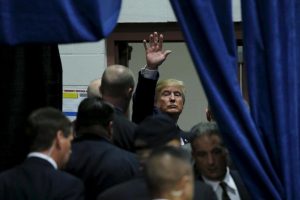 In early 1933, delegations of rank-and-file workers from all over Germany descended on the headquarters of the German Communist Party in Berlin. They were demanding that their leaders call a general strike to topple the newly appointed chancellor, Adolf Hitler. That tactic had worked in Russia, when the Bolsheviks organized a successful general strike to prevent the proto-Fascist general Kornilov from marching on the capital and overthrowing the liberal Kerensky government.
In early 1933, delegations of rank-and-file workers from all over Germany descended on the headquarters of the German Communist Party in Berlin. They were demanding that their leaders call a general strike to topple the newly appointed chancellor, Adolf Hitler. That tactic had worked in Russia, when the Bolsheviks organized a successful general strike to prevent the proto-Fascist general Kornilov from marching on the capital and overthrowing the liberal Kerensky government.
The Bolsheviks did not like Kerensky, but they knew that for them, Kornilov would be so much worse. German workers were familiar with Nazis and their brutality from their neighborhoods and workplaces, so they knew that Hitler in power would also be really bad news. To their amazement and dismay, the delegations met with only derisive dismissal. Hitler was nothing to worry about, their leaders told them. He would last no longer than any of his recent predecessors had. He would fall within weeks.
Hitler did not fall. During his first few months in office, he suspended the constitution, disbanded the parliament, imprisoned his political opponents, and forced all military officers to retake their oaths of office, this time to him personally, rather than to the constitution. The last of these became the primary impediment that prevented generals like Rommel from taking the action that they soon realized would be necessary until it was much too late.
Disgruntled Democrats and love-struck Republicans who still hold out hope that they can make a silk president out of a sow’s Trump are committing the same naïve blunder as those German Communists. They are thinking inside the proverbial box. The Fuhrer did not live inside that box, and neither does The Donald.
Hitler promised to “restore Germany to its proper place of glory among the nations.” He rose to power with the support of the SA, a private army of thugs and hooligans who reveled in the legitimacy they had suddenly acquired by being associated with a major political figure. Then, he bolstered his power with the support of the SS, a private army of disenfranchised young aristocrats who yearned to get back at least a semblance of the former titles and privileges they had lost as a result of Germany’s defeat in World War I.
 Trump promises to “make America great again.” He is supported by dozens of armed militias and biker gangs waiting in the wings for their leader to call them to action. The Rolling Stones learned what havoc biker gangs can wreak, when they naively hired the Hell’s Angels to provide “security” for their music festival in 1969. What they had intended to be the West Coast equivalent of Woodstock was turned instead into a fatal orgy of beating and stabbing. All it would take to deputize these thugs as an official SA/SS-type Presidential Guard, accountable only to Trump, would be an executive order.
Trump promises to “make America great again.” He is supported by dozens of armed militias and biker gangs waiting in the wings for their leader to call them to action. The Rolling Stones learned what havoc biker gangs can wreak, when they naively hired the Hell’s Angels to provide “security” for their music festival in 1969. What they had intended to be the West Coast equivalent of Woodstock was turned instead into a fatal orgy of beating and stabbing. All it would take to deputize these thugs as an official SA/SS-type Presidential Guard, accountable only to Trump, would be an executive order.
 Given Trump’s complaints that the election is being rigged against him, his declaration that he can lose only if the election is rigged, and his call to his followers to monitor polling venues in problematic neighborhoods on election day, we can expect to see action from these people even if he loses.
Given Trump’s complaints that the election is being rigged against him, his declaration that he can lose only if the election is rigged, and his call to his followers to monitor polling venues in problematic neighborhoods on election day, we can expect to see action from these people even if he loses.
Hitler never received more than 40% of the vote the several times he ran for president, usually much less, but the man who defeated him eventually appointed him chancellor, because there was no one else left, and his storm troopers were causing so much trouble. Benito Mussolini, for whom Trump has expressed some admiration, became prime minister of Italy in a similar way. Even without Trump’s winning the presidency, try to imagine some future president having to appoint Trump secretary of state, defense, or treasury just to shut him up. (By the way, how will Trump’s “observers” know whether someone is “voting five times,” since for them, all of “those people” look alike?)
When reporters asked Al Gore what he intended to do after the Supreme Court gave the 2000 election to George W. Bush, he replied that he would do nothing, because the only recourse in our system to such a decision would be violent revolution, and that sort of thing did not interest him. Trump is not Gore. As he keeps reminding us about himself, “I do not lose.” His suggestion that potential Clinton judicial appointments might be neutralized by “the second amendment people” was not an assassination threat, nor was it sarcastic or a joke. It was a heads-up to his troops.
President Obama’s characterization of Trump as “unfit to do this job” was, characteristically, graciously understated. Trump’s recent behavior, most notably his attack on the Khan family and his claim that Obama was the founder of ISIS, has begun to resemble that of the Roman emperor, Caligula, even more than that of Hitler.
Roman emperors were nominally required to seek Senatorial approval for their decisions, but the Senate had long since become a rubber stamp. The U. S. Congress has a similar history of powerlessness in the face of certain kinds of presidential faits accomplis.
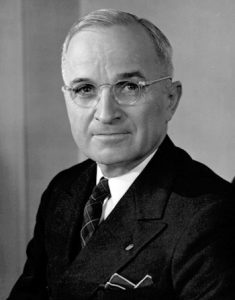
Harris S Truman http://www.trumanlibrary.org/photographs/view.php?id=2267 Credit: Frank Gatteri, United States Army Signal Corps
Harry Truman embarked on a major war entirely on his own, without receiving or even seeking the constitutionally mandated congressional declaration of war. Ronald Reagan violated the constitutional prohibition of granting special status to one religion over others by becoming the first U.S. president to appoint an ambassador to the headquarters of the Roman Catholic Church.
Would any president appoint an ambassador to the Christian Science Mother Church in Boston or the main Mormon Temple in Salt Lake City? In neither Truman’s nor Reagan’s case did anyone in Congress raise even a peep of objection out of fear of alienating important electoral constituencies. Constitutional requirements simply vanished without a whimper, let alone a constitutional amendment. With Trump in the White House, Congressional impotence will be complete, not so much because of electoral constituencies, even assuming that elections will still matter, but because of Trump’s militias.
Trump’s declaration that Hilary Clinton “is the devil” is similarly Caligulesque. Roman emperors typically looked forward to achieving godhood through an apotheosis that they expected to take place at their deaths. Caligula believed that he was already a god during his lifetime. In Trump’s case, if Clinton is the devil, and Trump is her nemesis, then Trump must be –– well, you figure it out.
Outside of the context of a presidential election, it might actually be amusing, in this connection, to take note of the fact that the Jewish Gematria value for The Donald is 282, the same as the value for Satan (http://www.gematrix.org/), and that the value for Donald J. Trump is 1,189, the same as the value for both The Fool Is The Devil and The Destruction Of The Planet. (Wikipedia defines Gematria as “an Assyro-Babylonian-Greek system of alphanumeric code/cipher later adopted into Jewish culture that assigns numerical value to a word/name/phrase in the belief that words or phrases with identical numerical values bear some relation to each other or …to the number itself as it may apply to Nature, a person’s age, the calendar year, or the like.”)
To be fair, it must also be noted that the Gematria value for Hilary Rodham Clinton is 953, the same as the value for both Multitude Of Sins and Fraudulent Concealment, but it is definitely not the value of The Devil, which is 851. Bernie Sanders, by the way, scores 451, the value of As Dead as a Doornail. This is metaphorically accurate right now, but is likely to become literally true, if Trump gets presidential power.
Believers in reincarnation might find it significant that Trump was born just over a year (June 14, 1946) after Hitler committed the sin of suicide (April 30, 1945). Believers in the Book of Revelation might find this helpful in explaining why Trump has been making himself look increasingly like the most qualified candidate for Antichrist that the world has seen in seventy years.
Trump is correct, contra Clinton, that this country “is going to Hell.”
Who would be better to make that determination than Gematria 282? On the other hand, this is not the fault of immigrants, legal or illegal, but is more a result of the persistent efforts of people like Trump to avoid paying appropriate taxes. The seven billion dollars that Trump’s family alone would save from Trump’s proposed elimination of the estate tax would make a good down payment on his wall, or, lest we forget, toward rebuilding schools, hospitals, highways and bridges. These are, after all the aspects of the country that are indeed “going to Hell.”
Despite scoffers, Trump will certainly be able to build his wall, and he will be able to make Mexico pay for it. At least, he will start. All it will take is an executive order seizing all Mexican assets in the United States for what the president will have decided is an essential governmental purpose.
Trump has a history of getting away with invoking eminent domain for personal gain, and he has made it clear that he will run his political empire exactly as he has run his financial one.
Like Trump University, the wall will likely never be finished, because the money will run out, as a result of budget overruns and kickbacks for Trump-connected construction companies and Trump-appointed inspectors. Mexico will be no more able to prevent this seizure than Austria (or more recently Crimea) was to prevent the Anschluss. Any Supreme Court that would declare Trump’s action unconstitutional will likely have ceased to exist by the time it gets to hear the case. The United Nations might wring its hands and express its outrage, but it will be as helpless to do anything meaningful as the League of Nations was when Mussolini took Ethiopia.
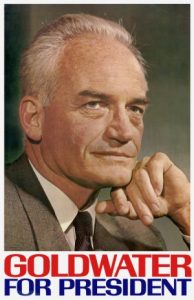
By Goldwater for President 1964 – https://campaignrhetoric.files.wordpress.com/2011/04/goldwater.jpg, Public Domain, https://commons.wikimedia.org/w/index.php?curid=50332089
Trump has been compared to Barry Goldwater, and there is some truth to that. Goldwater embraced the far-right John Birch Society, while Trump has accepted support from the Ku Klux Klan and recently appointed a modern-day equivalent of Joseph Goebbels as the CEO for his campaign. Hearing the head of The Trump Organization call the Clinton State Department “a criminal organization of pay to play,” just because she might have been overly gracious in thanking people for donating to a charity, would have brought an admiring smile of approval to the lips of the Nazi propaganda minister. It’s like Al Capone calling Eliot Ness a gangster, just because he might have inadvertently conducted a couple of wiretaps without a warrant.
On the other hand, Goldwater had a coherent political ideology that he remained more or less loyal to throughout his political career. Hitler also had a consistent lifelong ideology, but without the deep commitment to constitutionality that Goldwater professed, replacing it with “the will of the leader” as the source of legal legitimacy. Trump has shown no ideological consistency whatsoever, as shown by his recent apparent about-face-(but-not-really) on immigration just because his poll numbers were down, and he has expressed his contempt for any kind of “tradition” in favor of his own narcissistic notion of what he calls “common sense” as his sole guiding principle. In other words, Trump is loyal to nothing but Trump. As the proverbial twentieth-century General Motors executive might say now, “What’s good for Trump is good for Trump. Forget the USA.”
Consider Trump’s alleged on-again off-again “relationship” with Vladimir Putin. Trump was confidently asserting that Clinton’s emails had been hacked well before it was officially revealed that they had indeed been hacked by the Russians. How could he have known? Bush said that he had looked into Putin’s eyes and seen his soul. John McCain said that he had looked into Putin’s eyes and seen three letters, K-G-B. When Trump looks into Putin’s eyes, or anyone else’s, he sees only dollar signs. It would not be beyond the limits of a Trump-type deal to trade U. S. membership in NATO for a string of Trump golf courses across Russia. Business is business. Trump’s daughter recently vacationed in Croatia with Putin’s girlfriend. Perhaps, it was just a social visit.
Nobody took Hitler seriously when he wrote in Mein Kampf that he would like to gas thousands of Jews. How could this have been anything but rhetoric? Trump shrugs and smiles when his supporters yell out at rallies or tell interviewers that Clinton and other current government officials should be imprisoned or killed. He says he wants to keep Muslims and Mexicans out of the country, and that those who are already here are criminals and terrorists. What does one do when one has large populations of criminals and terrorists, too many to deport, a mostly built wall that can help to keep them from leaving voluntarily, and a “deportation force” of armed hooligans eager to kick butt?
Trump says he will reinstate water boarding and worse, because “torture works.” His recently former top campaign aide lobbied for foreign torturers for decades, most notably the pro-Putin former president of Ukraine. And then there is the admiration that Trump has expressed toward the mafia. Like torturers, “They get things done.” Based on his professed values and his actual business practices, in fact, Trump has shown himself to be not a businessman, but a gangster, Whitey Bulger in a suit. Bulger would have sent his thugs after the Khans. Trump is polished just enough to have realized that at least for now, he had to settle for insults and insinuations. Trump is what Bulger would have become, if he had inherited $40 million.
Clinton, of course, is everything the pre-endorsement Sanders said she is. A Clinton presidency would indeed be business as usual, with emphasis on both business and, in contrast to Trump, as usual. However, she is no more hypocritical than, say, McCain, who owns six mansions, but despite his war-hero status, refuses, like Trump, to pay his fair share of taxes to fund a war that he vehemently promotes. It is to Clinton’s credit, and it is not insignificant in this election, that she has never encouraged anyone to call her The Hilary.
Forget about Clinton’s emails, which would have been just as insecure on a government server as on her own, since anything on the network can be hacked, and just for the moment, put Benghazi aside as well. Of course, she lied.
So did Republican president and war hero Dwight D. Eisenhower, when he assured the American people on national television in 1959 that the United States did not send spy planes over the Soviet Union. That was exposed as a lie the very next day, when the Soviets showed captured American spy plane pilot Gary Francis Powers on their national television, thereby setting the stage for the anti-“establishment” cynicism of the 1960s. The idea that a president would lie to the public was still shocking to many people in those pre-Ellsberg, pre-Nixon days, but surely not today.
Rare indeed is the politician (or businessman, or parent, or spouse) who can get through life without ever telling a lie. However, most politicians are not pathological liars and compulsive career conmen who cannot distinguish true from false or right from wrong, the legal definition of insanity. In regard to credibility and trustworthiness, does a presidential candidate who refuses to release his tax forms, even though the IRS has said it would be okay, have the right to cast a stone?
The general strike that didn’t happen was the last chance the world had to prevent World War II, the Holocaust, and the need to invent nuclear weapons as a deterrent. The last chance the world will have to stop Trump and his consequences, if he wins the election, will be the moment after Mike Pence is sworn in as vice-president.
What a wonder it would be to behold, the entire United States Supreme Court going on strike, because they cannot in good conscience administer the oath of office to a lunatic. The justices are sworn, after all, to protect the constitution against its enemies, foreign and domestic, in whatever form they might appear. No one else is empowered to administer the presidential oath. Technically, Obama might still be president, but temperamentally, like Gore, he would be unlikely to press that claim in such a circumstance, nor is anyone who matters likely to take him seriously, if he did. Conservatives would actually get one of their own as president, and everyone else could breathe a sigh of relief that for at least another four years, there would be no mushroom cloud. The ongoing need to deal with Trump’s storm troopers would perhaps be one thing the two parties can agree on, and that would at least be a start.
Of course, all of the pieces would have to fall into place for this scenario to work out. A simpler and less risky path for Republicans, as some seem to have begun to realize, would be simply to let or even help Clinton win and then work to control her from Congress, as they have been doing more or less successfully with Obama. Taking everything into account, they will never be able to do that with Trump.
Given his enormous wealth, the demonstrated competence of his friend Putin’s hackers, and the apparent persistent willingness of top Republican leaders to put up with anything from Trump as long as he promises them tax cuts, Trump can actually win this election, regardless of what the polls might tell us. If he does win, and if he actually gets to hold office, hold on to your hat. The rollercoaster will be out of control and, “Believe me,” as in 1933, things will begin happening “fast.”
Trump recently told a largely white audience, aiming his question at the few black people there, that “58% of your youth are unemployed. And asked, “What do you have to lose?” The obvious answer, of course, is “the other 42%.”
Sure, you can’t trust Clinton to tell you the truth about everything she does. Of course, not. However, in contrast to Trump, you definitely can trust her not to fly off the handle and launch nuclear missiles in a fit of pique, just because some two-bit mini-Trump in some other country has made some offhand remark that she’s decided to consider insulting.
If you are one of those people who are still considering joining the ranks of those German Communists in repeating a world-historical blunder that you might not live long enough to know you should regret, then ask yourself three questions. Would you entrust Bernie Madoff with the password to your bank account? Would you entrust Bill Clinton with the keys to your teen-age daughter’s bedroom? Do you really want to entrust the likes of Donald Trump with the keys to the nation’s nuclear codes? Then, in Trump’s words, let “common sense” prevail, and as Ted Cruz said at the Republican convention, vote your conscience.
Guest author Steven Cushing is an internationally respected writer, consultant and educator on language, logic, and communication. His many publications include Fatal Words: Communication Clashes and Aircraft Crashes, “Critique of Puerile Reason: A Pragmatic Look at J. P. Moreland’s The Creation Hypothesis,” and How You and Your Computer Think Alike–and Don’t: An Exploration into the Nature of Mind. Like Bernie Sanders, he is a veteran of many of the progressive struggles of the 1960s and ‘70s, and he has also contributed to numerous government-sponsored projects involving most notably civil defense, aviation safety, computer security, and cryptography. He currently teaches in Cambridge, MA and can be reached most readily at stevencushing@alum.mit.edu.
His views do not necessarily reflect those of the publisher.
We thought our readers would like to know about “Convergence and the Future of Health,” a report released today by the Massachusetts Institute of Technology. (Slightly self-serving full disclosure: New Cambridge Observer‘s Anita Harris was one of the writers).
CAMBRIDGE, MA — What if lost limbs could be regrown? Cancers detected early with blood or urine tests, instead of invasive biopsies? Drugs delivered via nanoparticles to specific tissues or even cells, minimizing unwanted side effects? While such breakthroughs may sound futuristic, scientists are already exploring these and other promising techniques.
But the realization of these transformative advances is not guaranteed. The key to bringing them to fruition, a landmark new report argues, will be strategic and sustained support for “convergence”: the merging of approaches and insights from historically distinct disciplines such as engineering, physics, computer science, chemistry, mathematics, and the life sciences.
The report, “Convergence: The Future of Health,” was co-chaired by Tyler Jacks, the David H. Koch Professor of Biology and director of MIT’s Koch Institute for Integrative Cancer Research; Susan Hockfield, noted neuroscientist and president emerita of MIT; and Phillip Sharp, Institute Professor at MIT and Nobel laureate, and will be presented at the National Academies of Sciences, Engineering, and Medicine in Washington on June 24.
The report, available at http://www.convergencerevolution.net/2016-report draws on insights from several dozen expert participants at two workshops, as well as input from scientists and researchers across academia, industry, and government. Their efforts have produced a wide range of recommendations for advancing convergence research, but the report emphasizes one critical barrier above all: the shortage of federal funding for convergence fields.
“Convergence science has advanced across many fronts, from nanotechnology to regenerative tissue,” says Sharp. “Although the promise has been recognized, the funding allocated for convergence research in biomedical science is small and needs to be expanded. In fact, there is no federal agency with the responsibility to fund convergence in biomedical research.”
The National Institutes of Health (NIH) are the primary source of research funding for biomedical science in the United States. In 2015, only 3 percent of all principal investigators funded by NIH were from departments of engineering, bioengineering, physics, biophysics, or mathematics. Accordingly, the report’s authors call for increasing NIH funding for convergence research to at least 20 percent of the agency’s budget.
Progress and potential
 In 2011, MIT released a white paper that outlined the concept of convergence. More than just interdisciplinary research, convergence entails the active integration of these diverse modes of inquiry into a unified pursuit of advances that will transform health and other sectors, from agriculture to energy.
In 2011, MIT released a white paper that outlined the concept of convergence. More than just interdisciplinary research, convergence entails the active integration of these diverse modes of inquiry into a unified pursuit of advances that will transform health and other sectors, from agriculture to energy.
The new report lays out a more comprehensive vision of what convergence-based research could achieve, as well as the concrete steps required to enable these advances.
“The 2011 report argued that convergence was the next revolution in health research, following molecular biology and genomics,” says Jacks. “That report helped identify the importance and growing centrality of convergence for health research. This report is different. It starts us off on a true strategy for convergence-based research in health.”
The report released today makes clear that, despite such obstacles, this “third revolution” is already well underway. Convergence-based research has become standard practice at MIT, most notably at the Koch Institute and the Institute for Medical Engineering and Science. 
“About a third of all MIT engineers are involved in some aspect of convergence,” says Sharp. “These faculty are having an enormous impact on biomedical science and this will only grow in the future. Other universities are beginning to evolve along similar paths.”
Indeed, convergence-based approaches are becoming more common at many other pioneering university programs, including the Wyss Institute for Biologically Inspired Engineering at Harvard University, and the University of Chicago’s new Institute for Molecular Engineering, among others.
The report also points to several new federal initiatives that are harnessing the convergence research model to solve some of society’s most pressing health challenges.
For example, the Brain Research through Advancing Innovative Neurotechnologies (BRAIN) Initiative, launched by the Obama administration in 2013, seeks to improve our understanding of how individual cells and neural circuits interact, in order to develop new ways to treat and prevent brain disorders. And the National Cancer Moonshot Initiative, launched earlier this year to accelerate research to develop cancer vaccines and early detection methods and genomic tumor analysis, will also operate largely using convergence tools and approaches.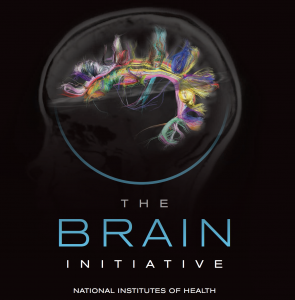
But the integration of new technologies and methods from genomics, information science, nanotechnology, and molecular biology could take us even farther.
The report outlines three major disease areas — brain disorders, infectious diseases and immunology, and cancer — and promising convergence-based approaches to tackling them. It also presents case studies of four emerging technology categories: advanced imaging in the body, nanotechnology for drug and therapy delivery, regenerative engineering, and big data and health information technology.
A sampling gives a sense of their transformative potential. Convergence techniques could enable rewiring the genes of mosquitoes to eliminate Zika, dengue, and malaria. They could help solve the emerging threat of drug-resistant bacterial strains, which infect over two million people in the U.S. every year. Convergence-based immunotherapy could activate a person’s immune system to fight cancer, reprogramming a person’s T-cells or antibodies to find and attack tumor cells. Big-data techniques could be used to generate and analyze huge amounts of data on people’s exposures to industrial chemicals, environmental toxins, and infectious agents, creating a new field of “chemistry of nurture,” to complement the “chemistry of nature” developed by the documentation of the human genome.
“Convergence might come just in time,” says Hockfield, “given our rapidly aging population, increasing levels of chronic disease, and mounting healthcare costs due to demographic trends throughout the developed world. But we must overcome significant barriers to get to convergence.”
Cultivating convergence
Realizing the full potential of the convergence revolution will require much more ambitious and strategic coordination and collaboration across industry, government, and academia, the report argues.
The report accordingly calls for a concerted joint effort by federal agencies, universities, and industry to develop a new strategic roadmap to support convergence-based research. As a concrete next step, the report’s authors recommend establishing an interagency working group on convergence with participation from NIH, the National Science Foundation, and other federal agencies involved in funding scientific research, such as the Food and Drug Administration and the Department of Energy.
Other pressing challenges include grant review processes based on narrow, outdated disciplinary structures, which limit the availability of resources for cross-functional research teams. The report also proposes new practices to foster “cultures of convergence” within academic institutions: cross-department hiring and tenure review, convergence “cluster hiring” and career grants, and new PhD programs wherein students design their own degree programs across disciplinary boundaries.
If the potential of convergence is great, so are the stakes.
“Convergence has grown from a little seedling to a sprouting plant, but to become a great tree and orchard yielding fruit for decades into the future, it needs to be nourished, expanded, and cultivated now,” says Sharp. “Students need to be educated, collaborations need to be encouraged, and resources need to be committed to make sure convergence thrives.”
“This integration is important to deal with the great challenges of the future: continued growth in the accessibility and quality of healthcare, growth of the economy, and providing resources for future populations.”
Funding for the report was provided by the Raymond and Beverly Sackler Foundation, The Kavli Foundation, and the Burroughs Wellcome Fund.
The report is available at http://www.convergencerevolution.net/2016-report
###
Written by Jonathan Mingle, MIT News correspondent
New Cambridge Observer is a publication of the Harris Communications Group, a Cambridge, MA, PR & marketing firm specializing in health, science and technology.
For the last few months, I’ve had the opportunity to work on an amazing national report about the Convergence of technologies in the life sciences. The goal of the report–which will be launched this coming Friday at the National Academy of Sciences, in Washington, DC– is to encourage increased funding for engineers, mathematicians, physicists, chemists, and information technologists for work in health and life science fields. More on the report and Convergence later this week.
For now, I want to let you know that Nobel Prize winning scientist Phil Sharp of the MIT Koch Institute has offered a $3000 award for the best Convergence idea submitted by students across the US–and that the public is invited to help choose a second, $1000 “community” winner—-by “liking” ideas submitted via on Facebook. The goal is to challenge emerging researchers to combine the life/physical sciences, information technology, social sciences, and engineering to improve human health.The voting deadline is 6 pm on Thursday, June 23, 2016.
Here’s a list of the submissions–which come from researchers across the US. More info on each idea–and “like” options– are available at https://www.facebook.com/ConvergenceIdeas/
–Anita M. Harris
New Cambridge Observer is a publication of the Harris Communications Group, a marketing and communications firm based in Kendall Square, Cambridge, MA.
The documentary movie “An Open Secret” does a wonderful job of exposing the sexual abuse of children in Hollywood. But you’ll probably never see it– not because of the difficult subject matter, but because almost no commercial theaters are willing to screen the film.
Written by Amy Berg, Lorien Hayes and Billy McMillin and directed by Berg, the 2014 film shows that abuse of child actors is pervasive in Hollywood and that most people in the industry know about it. Either they’ve been personally touched by it (pun intended) or know someone who has been. Many powerful people in Hollywood who could ruin the careers of anyone who pushes for justice on this issue are involved.
I applaud the subjects who were willing to share their painful stories and especially the teenager who actually went to court against his agent/abuser. The abuser got only six months in jail and is still in the industry despite solid proof of the exploitation.
Questions:
It’s a big story, so why isn’t anyone willing to distribute the film? Why has it been pulled from film festivals? Why after seeing the film have network executives refused to have the film on their networks? Why did the Screen Actor’s Guild unsuccessfully sue the filmmakers after seeing the film in which the head of their Young Performers Committee was implicated in the scandal?
Answer:
The topic is too hot to handle and hits too close to home.
Who can speak out for the innocent victims? In “Spotlight”, Hollywood is happy to pay homage to the reporters who uncovered sex abuse in the Catholic Church a number of years ago, but unwilling to acknowledge it in their midst.
In the past, I’ve attributed problems of child actors to their inability to handle fame and fortune and an acquired sense of entitlement. Now I wonder whether their spiraling out of control has far more nefarious roots.
I thank the Boston Globe for sponsoring the screening of this movie in its documentary series along with a Q&A session with the producer. I wish that others had the courage to take on this difficult topic and not bow to the powerful perpetrators, but who’s to take up the mantle? Newspapers are too financially strapped to take on such financially powerful interests so others such as documentary filmmakers or even comedians (like those who exposed Bill Cosby) need to raise our awareness and lead us to take action.
See the movie if you can and be outraged by the subject matter (child sexual abuse) and by the story behind the story (the unwillingness to deal with the “open secret”).
–-Sheila Green